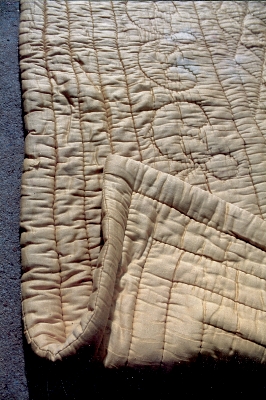Quilt No.55GPM - Griffith Pioneer Park Museum
2500 x 2000mm.
Brought to Australia in 1949 by Angela Zilliotto (born Torresan) 1915 - 1958 born at Crespano Del Grappa in the Veneto region of Northern Italy, possibly made by her mother.
Donated to Griffith Pioneer Park Museum by Angela's daughter, Nazzarina Zilliotto. Angela was the first wife of Milio Zilliotto.
"Recently Poineer Park acquired an item of particular interest � It was a handmade quilt from Italy donated by Maria Zilliotto in the name of her mother, Mrs Angela Zilliotto... [who] � died in 1958. As far as Maria knows, her mother brought it to Australia when she came to join her husband, Milio Zilliotto, in Griffith in 1949. Angela had been a teacher in Venica, but because of her lack of English took up dressmaking here.
The quilt is thought to have been made by Angela's mother� Italian households, like that of Angela's family, used to keep a few sheep. When a quilt was required, often to mark a special occasion such as a daughter's wedding, the fleece were stored up over a period of time until there was sufficient for the filling. Before making the quilt, the wool was washed, treated and spread between lining layers. Then the lining sandwich, with top and bottom covers, was stretched out on a frame. Several quilters might work on the quilt at once, moving around the frame as necessary. If a family did not do their own quilting, they would employ a specialist home quilter.
The design of the Zilliotto quilt is also reminiscent of the British quilts that have survived. Like them, it is a wholecloth quilt, made from the same material throughout � It is made from cotton sateen � Also popular in Britain, and uses similar simple geometric and floral designs - with a very Celtic look to the central motif. Two other quilts at the Zilliotto home shared these features, with plainer geometric design.. �
Perhaps the most unusual feature of the Zilliotto quilts is their thickness. � ..The Italian quilts however are three to four centimetres thick. They must have been even thicker before they were quilted, and before years of use packed the filling down - very difficult to sew through � but very warm."
[Robyn Oliver, curator Griffith Pioneer Park Museum, article in The Area News 16.8.1993]

Related Quilts:
2236 x 2236mm








